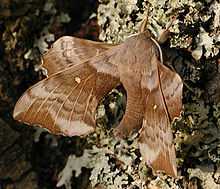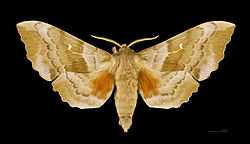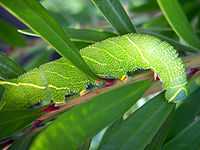Laothoe populi
| Laothoe populi | |
|---|---|
 | |
| Scientific classification | |
| Kingdom: | Animalia |
| Phylum: | Arthropoda |
| Class: | Insecta |
| Order: | Lepidoptera |
| Family: | Sphingidae |
| Genus: | Laothoe |
| Species: | L. populi |
| Binomial name | |
| Laothoe populi (Linnaeus, 1758)[1] | |
| Synonyms | |
| |
The Poplar Hawk-moth (Laothoe populi) is a moth of the family Sphingidae. It is found throughout the Palearctic region and the Near East and is one of the most common members of the family in the region.[2]
Description
This is a large (wingspan 70–100 mm), odd-looking, species due to its habit of resting with its hindwings held further forward than (but still half hidden by) the forewings (the species lacks a frenulum joining the wings together). It is said to look like a cluster of dead leaves of the main host, poplar. When disturbed, the moth will suddenly reveal a bright orange-red basal patch on the hindwing, possibly as a distraction or startle display. Gynandromorphs, half female and half male, are common.[2] The wings are grey marked with darker grey fascia but with the greys occasionally replaced by buffish tones (this form is more frequent among females than males).There is a white spot at the distal edge of the cell on the fore wings.
-
Mating pair showing both color variants.
-

Dorsal side - MHNT
-

△ Ventral side - MHNT
Life cycle
One or two broods are produced each year and adults can be seen from May to September. The adults do not feed. The species overwinters as a pupa.
Egg
The egg is large, spherical, pale green, and glossy, and is laid singly or in pairs on the underside of leaves of the host plant.[2] Females lay up to 200 eggs.
-

Egg
Larva
-

Larva
On first hatching the larva is pale green with small yellow tubercules and a cream-coloured tail horn. Later, it develops yellow diagonal stripes on its sides, and pink spiracles. Individuals feeding on willows may become quite heavily spotted with red. Others are more bluish white with cream stripes and tubercules. They are stout bodied, and grow to 65–85 mm.[2]
Pupa
The larva pupates in an earthen cell 2–3 cm below the surface, near its host plant. It has a short cremaster.[2]
Adult
Although they emerge late at night or early in the morning, the species flies starting from the second night and is strongly attracted to light. The proboscis is non-functional, so they do not feed as adults.[2]
Host plants
It feeds mainly on poplar and aspen but sometimes on willow, alder, apple, birch, elm, oak and ash. The food plant often depends on location.[2]
Subspecies
- Laothoe populi populi
- Laothoe populi lappona (Rangnow, 1935)
Notes
References
| Wikispecies has information related to: Laothoe populi |
| Wikimedia Commons has media related to Laothoe populi. |
- Chinery, Michael (1993) [1986]. Insects of Britain & Northern Europe: The Complete Insect Guide. Collins Field Guide. London: Collins. ISBN 0-00-219918-1.
- Pittaway, A.R. (1993) [1992]. The Hawkmoths of the Western Palaearctic. London: Harley Books. ISBN 0-946589-21-6.
- Skinner, Bernard (2009) [1984]. Colour Identification Guide to Moths of the British Isles (Macrolepidoptera). London: Harley Books. ISBN 87-88757-90-0.
